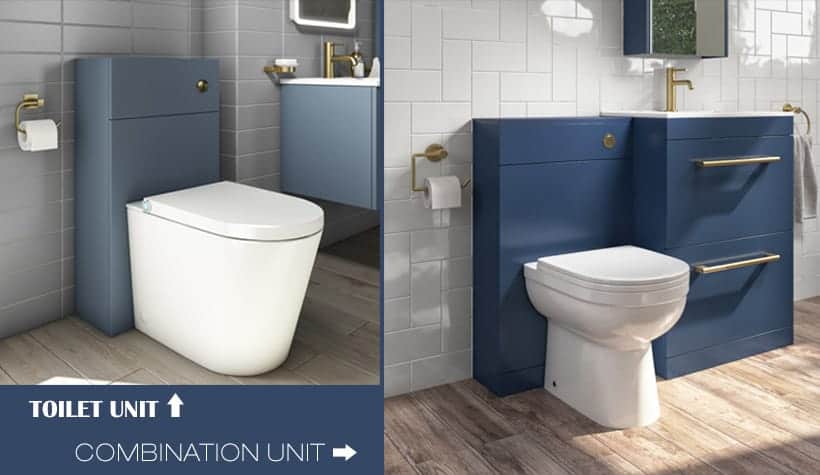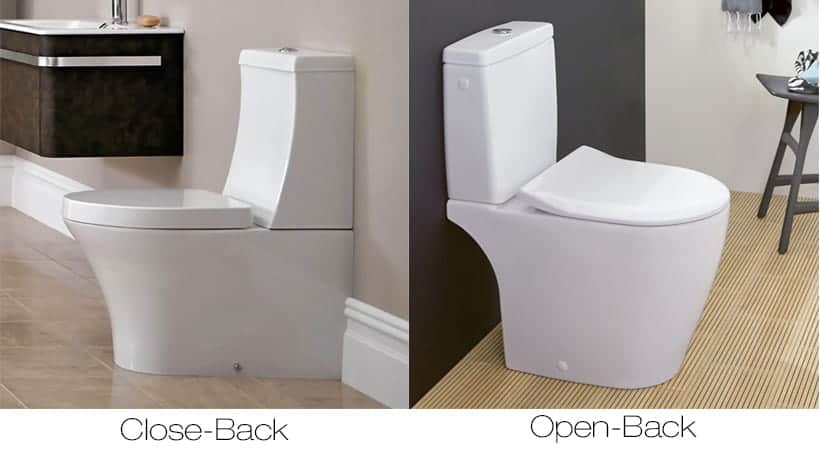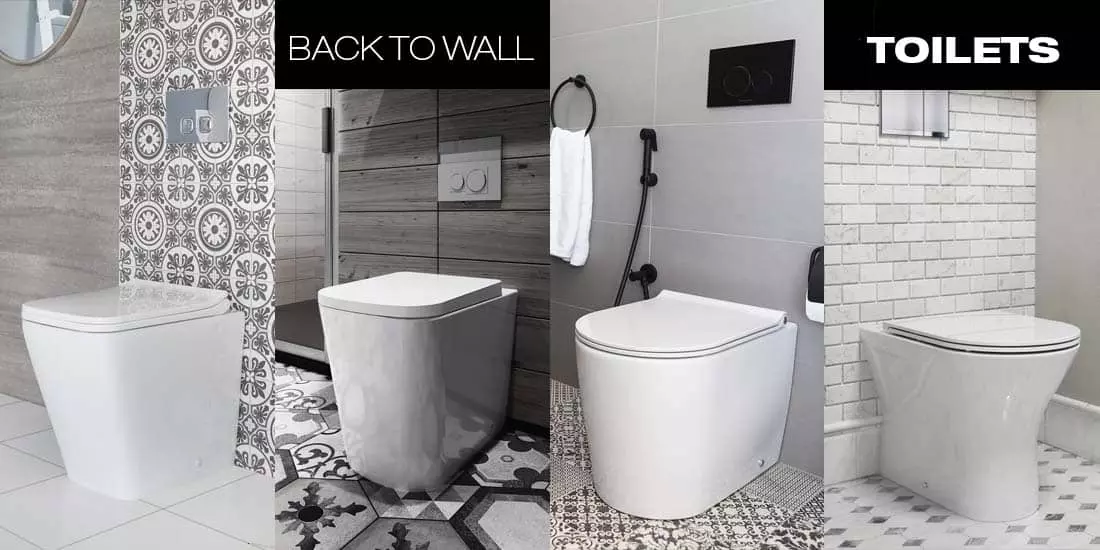A Worthy Choice For Cleanliness & Ease of Maintenance
Back to wall toilets are a terrific choice for creating a sleek, contemporary look because they come in various styles to match any bathroom decor and furniture. It is also a great alternative to the regular close-coupled toilet if you’re building a new bathroom and want something different, like a concealed cistern or hiding the ugly plumbing.
Whether your preference is aesthetics, ease of maintenance, or both, there is a huge range of back-to-wall toilets you can choose from. But before you can pick the right toilet, there are decisions to make which can affect your budget and the overall layout of your bathroom. So getting a good grasp of all the options can help you choose the ideal toilet that blends well with your bathroom decor and stays within your overall budget.
What Are Back to Wall Toilets?
Any toilet backed up against a wall is technically a back-to-wall toilet. After all, have you seen a toilet positioned far off any wall and sitting smack in the middle of a bathroom? Then why is the need to add “back to wall” when we can just say Toilet, which is understood will be seated against the wall?
Differentiation is the answer.
The term refers to a hidden cistern toilet in which the pan is fixed to the wall with the cistern concealed. The entire setup is quite similar to the wall-hung toilets, except the toilet pan is firmly in contact with the floor. Behind the wall is a support frame that holds the cistern, drain pipe and flushing mechanism, including the flush plate and buttons.
So, on the exterior, you will only see the pan and the flushing buttons on the wall that is right above the pan. Hence, the name back to wall toilets. And it is important to call a spade a spade here because it will eliminate confusion with the close-coupled and wall-hung toilets.
What Are The Advantages Against The Close-Coupled And Wall-Hung Toilets?
The clear advantage is the smaller space it takes up in the bathroom. Or, if you prefer the analogy that it makes the bathroom more spacious. And with the tank hidden, you have so much less area to clean, which is a productive advantage when you have tens of WC to take care of – such as public schools, governments and commercial buildings.
Also, when things appear minimal or look simple enough, you tend to do the cleaning more often.
If you have concerns about the weight limit that the wall-hung toilet poses, then the back to wall toilet pan is the perfect alternative. No matter what, the floor is more assuring than the wall when gravity is concerned.
Can You Replace a Regular Close-Coupled with a Back to Wall Toilet?
The short answer is yes. But that will depend on your budget and preparedness for a renovation. If you are not for wall hacking work, you can go for a simple WC toilet unit which boxes up all the plumbing from sight. Or you can opt for a combination unit with a wash basin and storage compartment if your bathroom has enough room for one.
But suppose you want to see a standalone toilet bowl backed directly against the wall. In that case, tempering with the wall is inevitable for a complete plumbing setup. All plumbing will need to be installed in the wall, which may need replacing the pipes and making future repairs more challenging owing to the difficult-to-reach areas. Use a detachable panel to make sure access is never a problem because of this.
And it depends on the wall build; is it a false wall or solid concrete? Whatever the case is, the budget is inevitably many folds that of the simple back to wall toilet unit.
The bulk of your money will go to wall material and labour work for hacking and rebuilding if it’s a tiled wall. Or setting up a support frame for a false wall to hold the cistern and pipework. That is when you are replacing the close-coupled loo with a btw pan. So, ensure you have a spare toilet you can use for days when the building work is in progress.
You can definitely replace any toilet type with a back to wall loo. The main considerations are your area size in the bath or cloak room and the plumbing setup. And not forgetting the compliance with the respective building and plumbing regulations. If you are not familiar with all the plumbing stuff, it’s best to consult a professional first before any purchase decision.
Here’s a video by an experienced hand on replacing a close-coupled WC with a toilet unit.

Wall Toilet Styles
Walled toilets are practical and ideal for smaller bathrooms. Depending on your preferences and constraints, selecting a toilet type isn’t all that difficult, given the wide range of back to wall toilets out there. Even a simple toilet unit can make a difference in your bathroom decor, but they are not necessarily low-cost.
Take the Geberit Monolith, for example. The module alone can be twice the price of the bowl or even more. But you will love the sleek appearance that comes in several matt or glossy colours and even aluminium and glass surfaces. Perfect for any contemporary backdrop besides being a great space-saving fixture.

Besides the Swiss manufacturer, there is no lack of local productions that offer the desired eye-pleasing aesthetics and functions. Most importantly, they cost a lot less, even with the installation cost.

And, as suggested above, a toilet and sink vanity unit could just be all you need to counter a space constraint and centralise all the plumbing for ease of maintenance. Perfect for an en-suite bathroom. The combo unit, which includes a back-to-wall toilet, cistern unit, and basin, offers an excellent solution for small spaces.
But if you are planning to renovate or build a new bath or cloakroom, it is definitely a great opportunity to consider a real wall toilet.
Close-Coupled Back To Wall Toilets
This will confuse you further if you are trying to understand the difference between close-coupled and back-to-wall toilets. That’s assuming you have read the definition of a wall toilet above. But everything is possible in our modern world, and nobody says you can’t have it close coupled and backed up to the wall.
In this case, the toilet is a two-piece close-coupled porcelain ware but fully backed against the wall with no exposure to the drain pipe at the rear. Technically speaking, it belongs to the close-coupled toilet category. Still, you can’t deny its back-to-wall status when it really is backed to the wall from top to bottom.

The advantage of such a design is for the ease of cleaning. Without a gap or hollow at the rear, dirt and dust can’t accumulate. You can save precious time in cleaning.
A more precise term for such a toilet is closed back toilet. And obviously, the open back refers to the common closed-coupled loo where the drain pipe is visible and easily accessible for maintenance work.
So, you have an additional choice here if you are not impressed with the toilet unit, and there is no way you will hack walls to conceal the cistern. And frankly, this may be a better idea if you prefer easy access to the cistern for maintenance purposes. Also, there is no lack of shape and style for a modern look if aesthetics is the main criterion.




